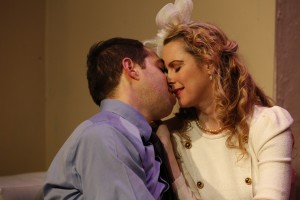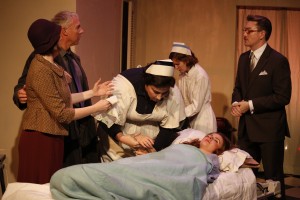At the curtain call of Sidney Kingsley's medical-crisis drama Men in White, a member of the Off-Off Broadway troupe The Seeing Place brandishes a clear-glass vase containing a little bit of folding money and assures the house that any contributions, however modest, will be appreciated. That polite solicitation is a reminder that it takes more than let's-put-on-a-show energy (which the cast has in abundance) to keep a theater company afloat. In the words of its promotional literature, the 27-member Seeing Place (that's a literal translation of the classical Greek noun theatron) is an "actor-driven company: built by actors, managed by actors to be a base for actors who want to grow and hone their craft in a creative and supportive artistic home." Men in White is the first of five socially conscious plays that The Seeing Place is offering as its fifth season.
Back in 1933, Men in White was the first successful production of another "actor-driven company" — the Group Theatre, which flourished in New York for most of the Great Depression. The play won the Pulitzer Prize; and, in 1934, MGM released a movie version starring Clark Gable and Myrna Loy. Over the years, Men in White has inspired hospital dramas on television from Ben Casey and Dr. Kildare to ER and Grey's Anatomy. (Kingsley's Detective Story has similarly provided a template for police dramas up to the present, with the Law and Order and CSI franchises.) The Seeing Place production is the first professional revival of Men in White in New York in three decades.
Set during the Depression, Men in White portrays life at various levels of St. George's, a cash-strapped private hospital in Manhattan. The protagonist, Dr. George Ferguson (Brandon Walker), is a high-minded intern of unusual promise, engaged to a socially-ambitious woman (Erin Cronican) whose father (Stewart Steinberg) is a benefactor of St. George's. Distressed by conflicting demands from his all-consuming vocation and his possessive fiancée, Ferguson turns for momentary sympathy to a nurse (Martine Moore) who shares his altruistic views. Predictably enough, melodramatic complications ensue. What's surprising is that Kingsley's old-fashioned dramaturgy raises issues — the ethics of abortion, for instance, and how healthcare should be financed — that are as urgent now as they were 80 years ago.
The narrative of Men in White is engaging; but the play is of interest principally because it's linked inextricably to the Group, a collective of actors, directors and writers inspired by the ideas of actor-director Konstantin Stanislavsky and committed to producing plays of social significance. The Moscow Art Theatre, which Stanislavsky co-founded, visited the United States a decade before the Group produced Men in White; its performances on Broadway and elsewhere during that tour had a profound effect on both playgoers and theater professionals. The New Republic critic Stark Young, who saw the troupe in January 1923, describes their work as "that rarest of events in the theatre anywhere, the combination of acting, producing and dramatic writing, one proceeding from another and all illuminating one idea."
The Group's production of Men in White was directed by Lee Strasberg, who later, as artistic director of the Actors Studio, would become the chief proponent of method acting. The cast included future acting gurus Sanford Meisner and Robert Lewis; future director Elia Kazan; and Clifford Odets, who would write the Group's greatest plays, Awake and Sing!, Waiting for Lefty and Golden Boy. The scenic designs by the distinguished Mordecai Gorelik included an operating-room set, innovatively lighted, for the crucial surgery scene, which was staged in a fashion that critics described as "balletic." Reviewing Men in White in The Nation, Joseph Wood Krutch said: "The effectiveness of the production can be credited less to any one element in it than to its remarkable wholeness, to the way in which everything in the acting and direction, as well as in the script itself, works with everything else to produce an unbroken continuity of interest and to leave behind a complete unified impression."
With its huge cast and complex staging demands, Men in White is a massive undertaking. The ostensive magic of the Group's original production was a function of gifted actors working full-time (unhindered by "days jobs"), with ample rehearsal time, since the collective-bargaining agreements of that era were less restrictive than those of today. Treading in the footprints of the Group Theatre is a daunting notion. The Seeing Place is to be commended for staging Men in White on a tight budget, with 16 actors covering 27 roles; and there's much that's admirable about what the cast accomplishes. Walker, in particular, gives a strong, thoughtful performance as Dr. Ferguson; and he's well-matched by Cronican in their several scenes together. Serving as both leading lady and director, however, Cronican may be on stage too much to have the bird's eye view necessary to direct a script as complicated as this one. The chaos of the climactic operating room scene, for instance, might have been averted if Cronican had viewed things from afar rather than being stuck in the center of the onstage action.
This presentation of Men in White doesn't approach the "remarkable wholeness" and "unified impression" that Krutch so admired in the Group's staging — the cast is uneven; what's suspenseful in the script is undercut by erratic pacing; even the Prokofiev that serves as entr'acte music is out of kilter with the mood of the dramatic material. But, for those interested in 20th-century drama, this is an opportunity, at a mere $12 per ticket, to experience a milestone work of the 1930s that's now nearly forgotten. And there's a plucky spirit to the production that's in sync with those Depression-era pioneers who founded the Group. That plea for donations at the curtain call, with the clear-glass vase and its small amount of folding money, is more than a testament to the difficulty of creating an environment in which artists may develop serious work in this costly city. It's a declaration that the theater deserves both passion and sacrifice.
Men in White by Sidney Kingsley presented by The Seeing Place at The Sargent Theater (in the American Theater of Actors, 314 West 54th Street) runs Wednesdays through Saturdays at 8 p.m., Saturdays and Sundays at 2 p.m., through Sunday, November 24. General admission $12.



